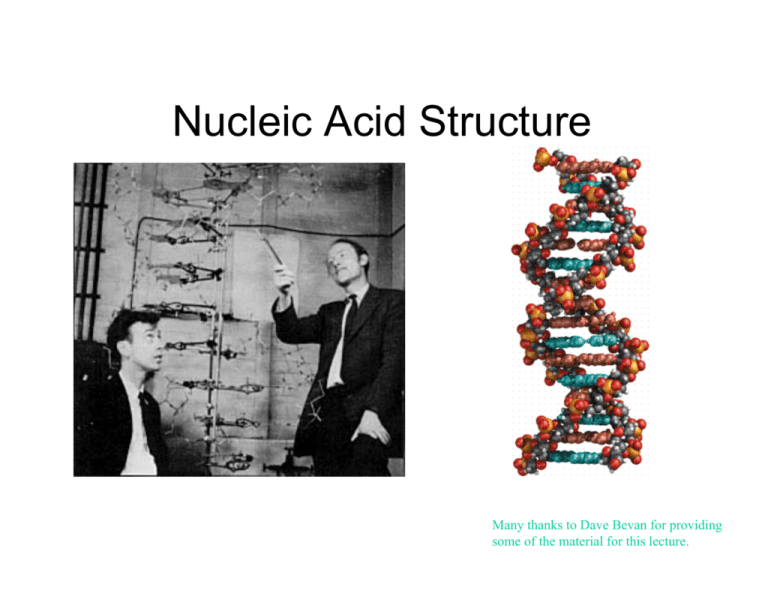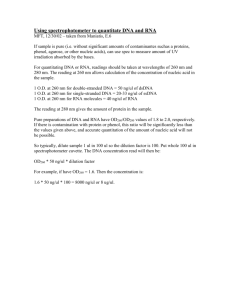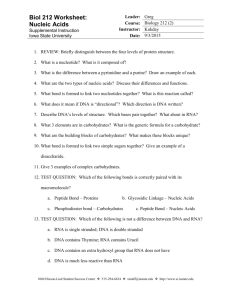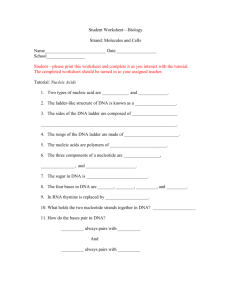Basic Biochemistry Related to Oxidation
advertisement

Nucleic Acid Structure Many thanks to Dave Bevan for providing some of the material for this lecture. The Central Dogma Nucleic Acids are Linear Polymers Berg, J.M. et al. (2002) Biochemistry, Fifth Edition, W.H. Freeman and Co. Structure of nucleotides Nucleotides have three characteristic components: A phosphate group A nitrogenous base (pyrimidines or purine) A pentose sugar The phosphate Carries a negative electric charge! The Sugars of Nucleic Acids Berg, J.M. et al. (2002) Biochemistry, Fifth Edition, W.H. Freeman and Co. Berg, J.M. et al. (2002) Biochemistry, Fifth Edition, W.H. Freeman and Co. The Bases of Nucleic Acids Berg, J.M. et al. (2002) Biochemistry, Fifth Edition, W.H. Freeman and Co. Backbones of DNA and RNA Berg, J.M. et al. (2002) Biochemistry, Fifth Edition, W.H. Freeman and Co. The major deoxyribonucleotides Nucleic acids Nucleotide monomers can be linked together via a phosphodiester linkage formed between the 3' -OH of a nucleotide and the phosphate of the next nucleotide. Two ends of the resulting polyor oligonucleotide are defined: The 5' end lacks a nucleotide at the 5' position, and the 3' end lacks a nucleotide at the 3' end position. Compare polynucleotides and polypeptides • As in proteins, the sequence of side chains (bases in nucleic acids) plays an important role in function. • Nucleic acid structure depends on the sequence of bases and on the type of ribose sugar (ribose, or 2'-deoxyribose). • Hydrogen bonding interactions are especially important in nucleic acids. Expectedly, weak bonds. Interstrand H-bonding between DNA bases Watson-Crick base pairing DNA structure determination • Franklin collected x-ray diffraction data (early 1950s) that indicated 2 periodicities for DNA: 3.4 Å and 34 Å. • Watson and Crick proposed a 3D model accounting for the data. DNA structure • DNA consists of two helical chains wound around the same axis in a right-handed fashion aligned in an antiparallel fashion. • There are 10.5 base pairs, or 36 Å, per turn of the helix. • Alternating deoxyribose and phosphate groups on the backbone form the outside of the helix. • The planar purine and pyrimidine bases of both strands are stacked inside the helix. Watson-Crick Base Pairing Berg, J.M. et al. (2002) Biochemistry, Fifth Edition, W.H. Freeman and Co. DNA strands • The antiparallel strands of DNA are not identical, but are complementary. • This means that they are positioned to align complementary base pairs: C with G, and A with T. • So you can predict the sequence of one strand given the sequence of its complement. • Useful for information storage and transfer! • Note sequence conventionally is given from the 5' to 3' end DNA Double Helix Backbones in darker blue and red. Bases in lighter blue and pink. 20 A Berg, J.M. et al. (2002) Biochemistry, Fifth Edition, W.H. Freeman and Co. Most prevalent Forms of DNA DNA Backbone Parameters DNA Grooves Berg, J.M. et al. (2002) Biochemistry, Fifth Edition, W.H. Freeman and Co. DNA Packing The DNA is flexible. It is important to understand how it bends. Why is this important? Here is the one reason that is often cited: 12 feet So the DNA in the cell must be really bent. One reason (out of many) why it is important to know how the DNA is folded up in the cell. The DNA in all your cells is identical. Yet cells are different. For instance, the DNA in the eye cells is exactly the same as in the tongue cells. But it is packed differently, exposing different parts for reading by the cell when it develops and functions. Roughly speaking, that is what makes cells of the same organism different from each other. Obviously, the folding will depend on how flexible the DNA is. Tightly bent DNA is a fact of life: ~100A ~30 bp ~ 80 A ~25 bp DNA looping DNA packing mediated by a in the nucleosome transcription factor ~500A ~ 145 bp DNA packing inside a virus Weakly and Tightly bent DNA. Persistence length. Weak bending. Energy << kT Tight bending, Energy >> kT The key length scale of a polymer: persistence length. Conventional value = ~145 pb or ~500A for DNA Classical elastic rod theory (Landau) Bending energy φ Hooke’s Law ∝φ 2 Harmonic WLC model. C E ≈ kTL ∫ ( 0 ∂t )ds ≥ kTφ 2 ∂s (In our case, L = C ~ 500A. ) DNA flexibility depends on its sequence! • It is very important to be able to predict this dependence (still not fully solved problem). • What’s more flexible: AAAAA TTTTTT Or: GGGGGG CCCCCC A-T linked by 2 H-bonds, but G-C by 3. Less room to wiggle, so less flexible. Ribose • An important derivative of ribose is 2'-deoxyribose, or just deoxyribose, in which the 2' OH is replaced with H. • Deoxyribose is in DNA (deoxyribonucleic acid) • Ribose is in RNA (ribonucleic acid). • The sugar prefers different puckers in DNA (C-2' endo) and RNA C-3' endo). Types of RNA • mRNA (messenger RNA) – Template for protein synthesis (translation) • tRNA (transfer RNA) – Carries activated amino acids to ribosome for protein synthesis – At least one kind of tRNA for each of the 20 amino acids • rRNA (ribosomal RNA) – Major component of ribosomes RNA has a rich and varied structure WatsonCrick base pairs (helical segments; Usually A-form). Helix is secondary structure. Note A-U pairs in RNA. DNA can form structures like this as well. Structure of tRNA RNA displays interesting tertiary structure Singlestranded RNA righthanded helix Yeast tRNAPhe (1TRA) Hammerhead ribozyme (1MME) T. thermophila intron, A ribozyme (RNA enzyme) (1GRZ) The mother of all proteins Made of proteins and RNA. Large subunit of the ribosome 1ffk Function: protein sysnthesis




